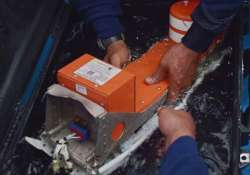Jakarta/Singapore: Multi-national search teams today continued to scour the choppy waters of the Java Sea to locate the fuselage of the crashed AirAsia jet, as the investigators were probing the black box recorders to get the vital information to unravel the mystery of the crash.
The flight data recorder and cockpit voice recorder, retrieved from the bottom of the sea this week, were being analysed by the experts who are now hopeful of finding answers to the mysterious crash of the Airbus 320-200 which plunged into Java Sea with 162 people on December 28.
The black box recorders, which are actually orange, are expected to shed new light on the mysterious crash that claimed all 162 lives on board the ill-fated AirAsia Flight QZ8501, en route from Indonesia's Surabaya city to Singapore.
Indonesia's National Transport Safety Committee is leading the probe, helped by experts from countries including France and the US.
Investigators may need up to a month to get a complete reading of the data to determine what caused the AirAsia group's first fatal accident half way into a two-hour flight.
Meanwhile, multi-national search and rescue (SAR) teams are supporting the Indonesian efforts to evacuate bodies and debris from the bottom of the sea.
"#QZ8501 Day 18. Search continues with 23 ships as assigned. Foreign warships on standby" Malaysia's Chief of Navy Abdul Aziz Jaafar tweeted this morning.
Only 48 bodies, including at least two strapped to their seats, have been found in the choppy waters so far despite over two weeks of search operations.
AirAsia said 36 of the bodies recovered from the sea have been identified, while 12 are still being identified.
Indonesia's National Transport Safety Committee head Tatang Kurniadi last night said, "100 per cent of the things we need are now in our hands" to investigate the accident.
Indonesia's National Search and Rescue Agency (Basarnas) chief Marshal Bambang Soelistyo has assured the families of those on the jet that the main SAR operation is still on-going and their main priority is to search and recover the passengers despite weather and underwater current challenges.
Bad weather and strong undersea currents has slowed down the SAR operations since the jet crashed in the Java Sea.
Search teams have possibly identified the locations of the plane's main fuselage and stabiliser, with divers reported to have marked out the spot the fuselage is believed to lie, 30 metres deep.
Search and rescue agency coordinator S B Supriyadi said the fuselage is believed to have been found northeast of where the tail section was previously spotted by a ship scanning for wreckage.
Finding the fuselage of the Airbus 320-200 is seen as vital, as most of the victims are believed to be still trapped inside.
Latest World News
